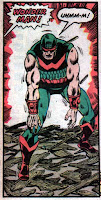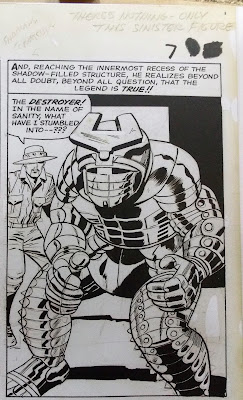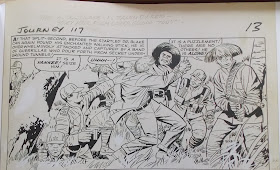Doug: Once again we welcome Thomas F. to the scribe's chair. Today he's sharing thoughts on a magazine that was a late-Bronze Age staple for many of us - What If? And lurking within the issue Thomas has chosen is a question stemming from the early 1970s -- What if Wolverine had killed the Hulk? Why wait? Read on!
What If? #31 (February 1982)
“What If Wolverine Had Killed the Hulk?”
Rich Margopoulos-Bob Budiansky/Mike Esposito/Bob Sharen
Thomas F.: The “What If”
comics were an intriguing concept: as fans are aware, they presented
hypothetical tales of an alternate reality. Usually based on a
significant event in the Marvel Universe, they tried to show
the direction history would have taken if things had unfolded
differently—sometimes very differently. Some of the stories have
unsettling and tragic outcomes, which will make the reader feel relieved
that they are just imaginary. The narrator of the story
is, as usual, the Watcher.
This invented tale features Wolverine. But in these early times, little was known about Wolverine. Still, a few facts were established:
(1) Wolverine, aka Logan, had been a Canadian field agent employed by the Canadian military;
(2) Wolverine was a mutant with an incredible healing factor;
(3) Wolverine had a skeleton constructed of adamantium, a virtually unbreakable metal;
(4) Wolverine had three razor-sharp, retractable claws on the back of each hand, which he used as offensive weapons;
(5) Wolverine had an extremely powerful sense of smell; and
(6) Wolverine possessed the savage instincts of an animalistic killer and had undergone drug therapy and “psycho-training” to curb these wild impulses of his.
BACKGROUND:
To evade the American military, the Hulk made his way into Canada and
fought a giant, Yeti-like cannibal beast in the woods
of Quebec known as the Wendigo. Alerted to the ferocious creatures
destroying the forest in the Canadian North Woods, the Canadian Armed
Forces sent a special adamantium-clawed field agent with a six-hour
deadline to capture the Hulk. Wolverine proved unsuccessful—he
was unable to defeat the Hulk in combat, and the Canadian military
intervened, sending a “crack-squad of specially-trained commandos” to
finish the job. They use a soporific gas against the Hulk, which worked,
but when the Green Goliath awakened, he easily
broke free and escaped. (These incidents took place in
The Incredible Hulk #s180-182, before the events of
Giant-Size X-Men #1, where Wolverine abruptly resigned his Canadian
commission and left with Professor X to join the new X-Men, who were
introduced in
X-Men #94).
300-WORD SYNOPSIS: This time around, Wolverine first incapacitates the Wendigo, then engages the Hulk in a fight to the finish. No quarter is given. Wolverine pits his tenacity, speed, and “diamond-hard” adamantium claws against the overwhelming strength of the Hulk. Caught up in the escalating intensity of the clash, Wolverine disregards the instructions of his superiors to apprehend the Hulk and decides to kill him instead. In a savage spate of fury, Wolverine repeatedly slashes away at the Hulk’s neck and succeeds in killing him.
Later, after a barroom brawl during which he loses control of himself, Wolverine is charged with murdering a civilian, and he deserts the Canadian Forces. Almost immediately afterward, Wolverine—now out of options and pursued by the law—is enlisted into the Brotherhood of Evil Mutants by the powerful Magneto, Master of Magnetism. Magneto tasks Wolverine with infiltrating the X-Men as a mole.
Over several weeks, Wolverine becomes a trusted member of the X-Men, training with the team in the Danger Room and helping to defeat the Sentinels. Wolverine is still committed to betray the X-Men for Magneto, although he does so with a troubled conscience, because he now considers the X-Men his friends. According to a prearranged plan, Wolverine disables Cerebro’s “proximity fuse,” which allows Magneto and his followers to break into X-Men headquarters without warning.
When Magneto and his mutant cronies—the Blob, Unus the Untouchable, Lorelei, and Mastermind—breach Professor Xavier’s School For Gifted Youngsters, they overwhelm the X-Men. But when Magneto tries to kill Jean Grey/Marvel Girl, for whom Wolverine feels affection, Wolverine turns on Magneto. Both inflict lethal injuries on one another: Wolverine slashes Magneto to death, and in his final moments, Magneto uses the power of magnetism to cause Wolverine to pierce himself in the throat with his own metal claws.
Before
reading this issue, I’d never heard of Rich Margopoulos. After looking
him up, I discovered that he’d written for Warren Publishing,
which produced the monster/horror comics Hunter the Demon Killer and
Vampirella. Margopoulos also wrote over at MLJ, now known as Archie Comics, and wrote at least one more
What If? story for Marvel (issue #38).  His influences were Steve Englehart and Roy Thomas.
His influences were Steve Englehart and Roy Thomas.
 His influences were Steve Englehart and Roy Thomas.
His influences were Steve Englehart and Roy Thomas.As for Bob Budiansky’s artwork, it’s average, in my opinion. Passable, but not extraordinary, though he is a good storyteller. Certainly not a big name, Budiansky is best known for writing The Transformers and penciling issues of Ghost Rider near the end of its run. Personally, I would have liked to see Herb Trimpe pencil this issue.
I thought I’d mention that as a Canadian myself, I have an affinity for heroes of Canadian origin, and appreciate it whenever Marvel or DC create Canadian characters, even if they’re almost invariably depicted as British replicas.
I love the scenes where Wolverine does the Hulk in. Wolverine’s relentless viciousness really makes an impact here.
Although it wasn’t known at the time of The Incredible Hulk #181, it was established years later that Wolverine’s metal claws did lacerate the Hulk’s tough skin, but the Hulk healed so quickly that he appeared to be uninjured.
The Hulk’s passing made a personal impact on at least two people, General “Thunderbolt” Ross and his daughter Betty. The general has mixed feelings of part relief and part regret now that his long-time nemesis has perished. As for Betty, she is immensely saddened because although she was certainly aware that the Hulk was very dangerous, she loved Bruce Banner, the man inside the monster. The rest of the world is understandably astounded to when they hear of the Hulk’s death on a news broadcast.
Wolverine’s tendency to succumb to a berserk rage is an appealing quirk of his.
 Unfortunately for him, this time it led to tragedy—when
a barfly pulled a gun on him, Wolverine acted instinctively and
skewered him like a shish-kebab.
Unfortunately for him, this time it led to tragedy—when
a barfly pulled a gun on him, Wolverine acted instinctively and
skewered him like a shish-kebab. 


































































